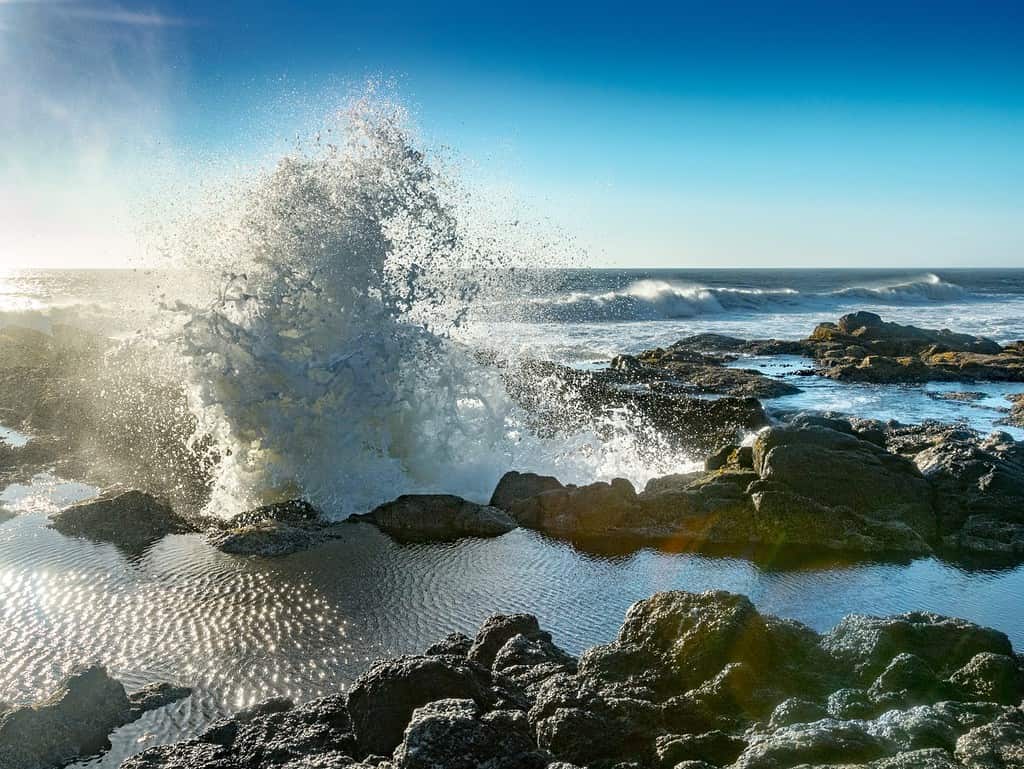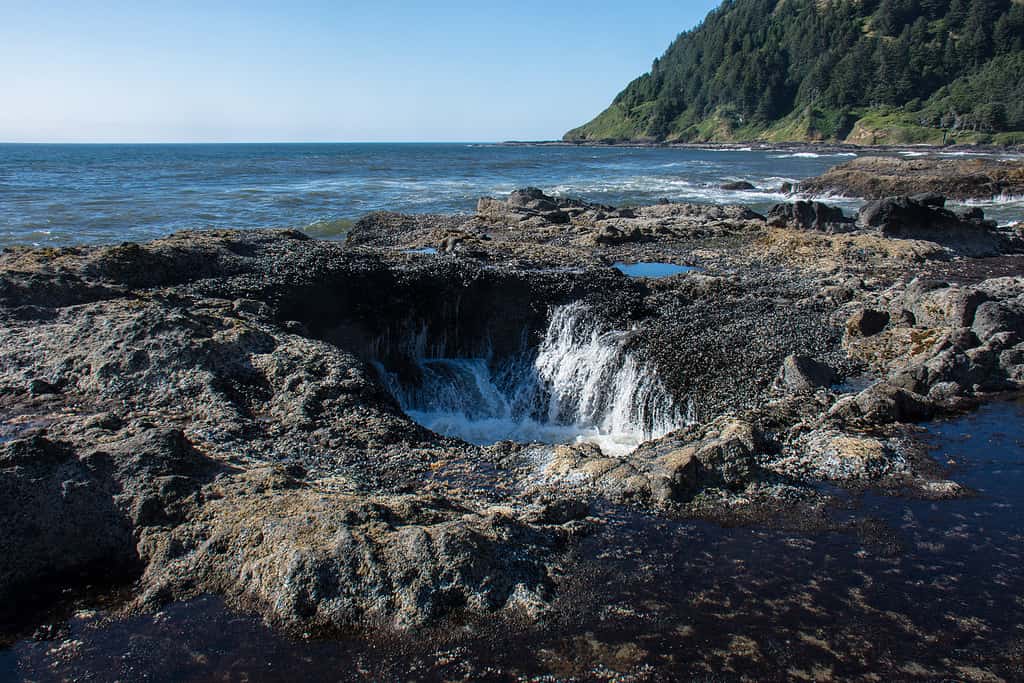There’s a place in Oregon known as Thor’s Well. It’s right on the ocean. As the name suggests, the well is a hole in the earth. But what makes this sinkhole a little more spectacular than others?
Because it’s right on the coast, it perpetually sucks in water from the ocean. Sometimes, if the conditions are right, it can even shoot water back out.
Interested? Keep reading below to learn about this bottomless sinkhole.
Where is Thor’s Well?
Thor’s Well is in Yachats, Oregon. It sits right along the ocean, near Cape Perpetua. It’s also sometimes called the drain pipe of the Pacific.
It’s right off Highway 101, so it’s the perfect place to stop during a long car ride and stretch your legs. From the parking lot to the viewing area is not a long hike, less than half a mile.
For those who want a little more exercise, there’s also a half-mile loop as part of the Captain Cook Trail. Because of the slippery basalt rocks, it’s best to wear tight-fitting shoes with a good grip.
What Is Thor’s Well?

Thor’s Well might not actually be bottomless, or even a sinkhole, but it’s hard to get rid of the story.
©Kelly vanDellen/Shutterstock.com
Thor’s Well is possibly a sinkhole, though there are arguments on whether or not this is true. From what can be seen of the hole, it appears bottomless. While scientists know it isn’t bottomless, discovering how deep down into the earth it goes isn’t easy.
However, it’s thought to not be that deep, probably around 20 feet or so. So maybe not as bottomless as first thought. When you look at it, though, it’s hard to not imagine it being an endless pit into the center of the earth.
The name of the well comes from the Norse God of Thunder, Thor. There was a story that circulated for a while stating that the hole came from Thor striking the area.
How Was Thor’s Well Created?
There’s not much known about the well. Some groups believe that it started as an ocean cave. As the waves eroded the rock, the cave grew larger, and the rocks thinner. Eventually, there was nothing left to hold up the ceiling and it collapsed, becoming the sinkhole known today as Thor’s Well.
The Best Time to Visit Thor’s Well

Thor’s Well may just look like a normal tidal pool during low tide, but it’s quite impressive at high tide or during storms.
©Melissa Kopka/iStock via Getty Images
Thor’s Well is a popular tourist attraction. You can visit it pretty much at any time. The best time to visit, though, is around high tide, or during violent storms.
During these times, the water washes over the rocks and creates a spectacular sight before sinking into the hole.
Many who have visited Thor’s Well several times in the past say to arrive an hour before high tide. That way, you have time to see the well in all its glory. Then, as time passes and the tide arrives, you have the chance to watch it fill up more and more with water.
At peak high tide, you may even get to witness water shooting back out of Thor’s Well. Sometimes, the water shoots out as high as 40 feet, looking more like a geyser than a sinkhole.
Thor’s Well is impressive at any time of the year and is open in every season. Oregon and the surrounding water do tend to get cold in the winter months, with an average temperature of 45 degrees Fahrenheit at Cape Perpetua. So if you want to be comfortable, visiting in other seasons is probably the better option.
The Dangers of Thor’s Well

Waves that might start off looking small can quickly turn into waves big enough to sweep away even the most sure-footed people.
©Lu Yang/Shutterstock.com
Thor’s Well isn’t just an interesting sinkhole to visit. It poses a pretty big danger. While the well is most spectacular during storms and high tide, these are also the times when it’s most dangerous.
When the water’s force is strong, it’s easy enough for visitors to fall into the waves and follow the water’s path into the sinkhole.
If the well is actually a collapsed sea cave, rather than a sinkhole, there is likely a fairly large second entrance. You may think that you could escape the cave that way and swim to safety.
However, due to the force of the water and the surging tides, those who fall into the hole are much more likely to get tossed around on the rocks and be at the mercy of the waves. Even the most powerful swimmers would find themselves unable to fight against the current.
The area is also known for sneaker waves. These waves are ones that often sneak up on people on the beach and standing alongside the rocks. Sometimes, these waves aren’t visible until they surge. Or, they may start off looking small but surge much higher than expected.
Viewers of Thor’s Well may look at the ocean and see no danger coming, not realizing a sneaker wave is on its way.
The photo featured at the top of this post is © Wirestock/iStock via Getty Images
Thank you for reading! Have some feedback for us? Contact the AZ Animals editorial team.







